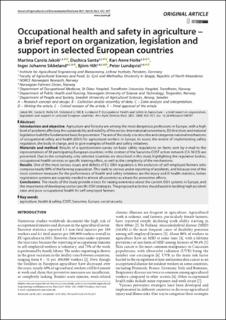| dc.contributor.author | Jakob, Martina Carola | |
| dc.contributor.author | Santa, Dushica | |
| dc.contributor.author | Holte, Kari Anne | |
| dc.contributor.author | Sikkeland, Inger Johanne | |
| dc.contributor.author | Hilt, Bjørn | |
| dc.contributor.author | Lundqvist, Peter | |
| dc.date.accessioned | 2022-10-03T13:49:08Z | |
| dc.date.available | 2022-10-03T13:49:08Z | |
| dc.date.created | 2021-10-12T16:45:59Z | |
| dc.date.issued | 2021 | |
| dc.identifier.citation | AAEM: Annals of Agricultural and Environmental Medicine. 2021, 28 (3), 452-457. | en_US |
| dc.identifier.issn | 1232-1966 | |
| dc.identifier.uri | https://hdl.handle.net/11250/3023422 | |
| dc.description.abstract | Introduction and objective: Agriculture and forestry are among the most dangerous professions in Europe, with a high level of accidents affecting the sustainability and viability of the sector. International conventions, EU directives and national legislation build the fundamental basis for prevention. The aim of the study is to describe and categorize national mechanisms of occupational safety and health (OSH) for agricultural workers in Europe, to assess the extent of implementing safety regulation, the body in charge, and to give examples of health and safety initiatives. Material and methods: Results of a questionnaire-survey on basic safety regulations on farms sent by e-mail to the representatives of 30 participating European countries in the context of the Sacurima COST action network (CA 16123) are presented. Due to the complexity, only selected countries are described in this study highlighting the regulative bodies, occupational health services or specific training offers, as well as the complexity of the mechanisms. Results: One of the most serious issues and deficits of EU OSH regulation is the exclusion of self-employed farmers who compose nearly 90% of the farming population. This leads to serious under-reporting of accidents, and because one of the most common measures for the performance of health and safety initiatives are the injury and ill health statistics, better registration systems are urgently needed in almost all countries as a basis for preventive efforts. Conclusions: The results of the study provide a basis for raising awareness about the current OSH systems in Europe, and the importance of developing sector specific OSH strategies. The proposed activities should assist in tackling high accident rates and poor occupational health for self-employed farmers. | en_US |
| dc.language.iso | eng | en_US |
| dc.rights | Navngivelse-Ikkekommersiell 4.0 Internasjonal | * |
| dc.rights.uri | http://creativecommons.org/licenses/by-nc/4.0/deed.no | * |
| dc.title | Occupational health and safety in agriculture– a brief report on organization, legislation and support in selected european countries | en_US |
| dc.title.alternative | Occupational health and safety in agriculture– a brief report on organization, legislation and support in selected european countries | en_US |
| dc.type | Peer reviewed | en_US |
| dc.type | Journal article | en_US |
| dc.description.version | publishedVersion | en_US |
| cristin.ispublished | true | |
| cristin.fulltext | original | |
| cristin.qualitycode | 1 | |
| dc.identifier.doi | 10.26444/aaem/140197 | |
| dc.identifier.cristin | 1945434 | |
| dc.source.journal | AAEM: Annals of Agricultural and Environmental Medicine | en_US |
| dc.source.volume | 28 | en_US |
| dc.source.issue | 3 | en_US |
| dc.source.pagenumber | 452-457 | en_US |

